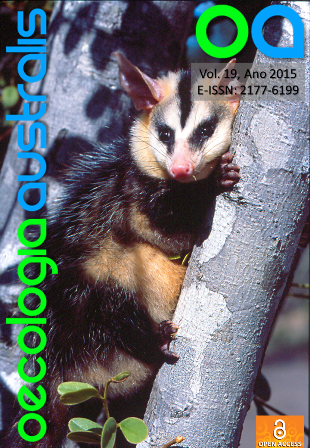Litter size and embryo implantation in Neotropical rodents
DOI:
https://doi.org/10.4257/oeco.2015.1901.12Palavras-chave:
Echimyidae, placental scars, reproduction, Rodentia, SigmodontinaeResumo
Research on the biology of Neotropical small mammals has increased in recent decades, and many studies have emphasized ecological and population attributes, but information on reproduction is still scarce. Reproduction is one of the most important natural history attributes because it is tied to almost every structural, physiological and behavioural adaptation of an individual or a species. Most research on rodent reproduction concentrates in temperate areas and there is an evident lack of data from the Neotropical region. We compared reproductive patterns of sigmodontine and echimyid rainforest rodents. We obtained necropsy data from 135 specimens collected in the field and belonging to 22 species of sigmodontine and 8 species of echimyid rodents. We estimated embryonic litter size by counting the number of embryos or the number and placement of placental scars in pregnant and parous females. Although smaller in body size, sigmodontines have larger litter sizes (3.6 À 1.2) than echimyids (2.1 À 0.7), indicating a tendency toward r and k reproductive strategies, respectively. Embryonic litter size in pregnant females was not statistically different from the number of placental scars, so the latter is a reliable estimate of the former in both sigmodontines and echimyids. Embryo implantation is asymmetric regarding uterine horns in sigmodontines, with predominance in the right horn, but not in echimyids. The relevance and biological implications of such patterns are still unknown.Downloads
Arquivos adicionais
Publicado
2017-02-23
Edição
Seção
Artigos


